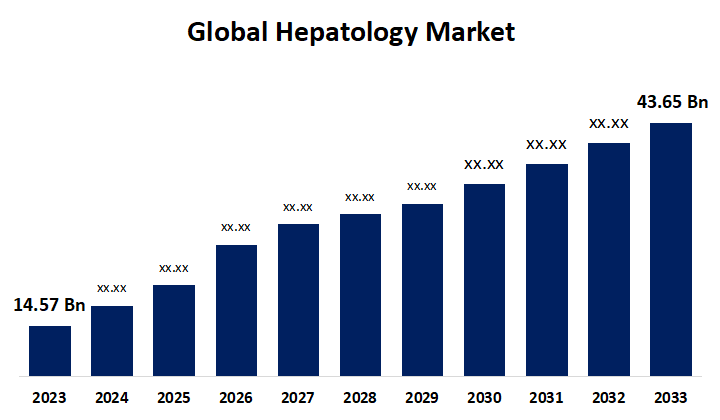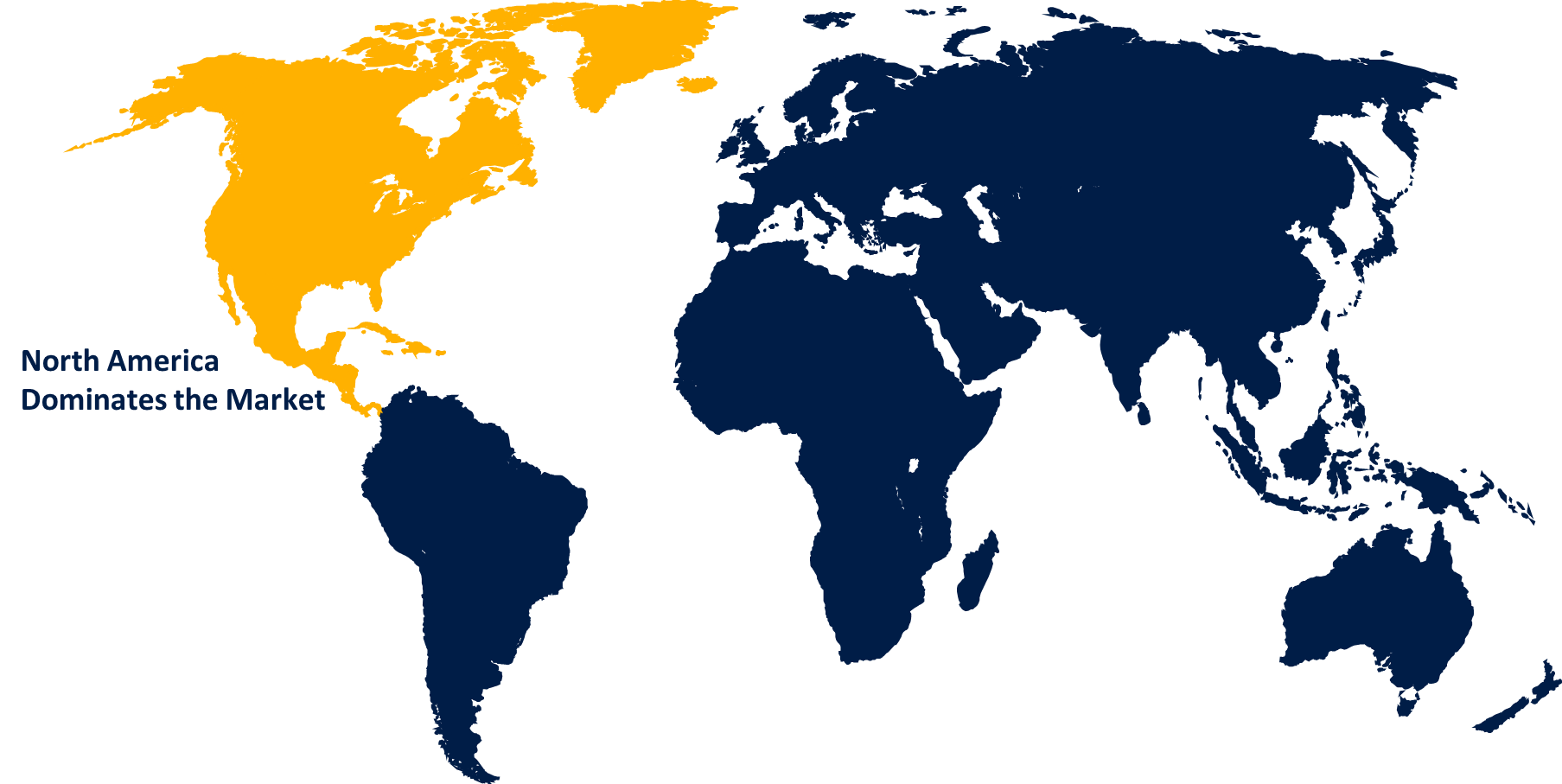Global Hepatology Market Size, Share, and COVID-19 Impact Analysis, By Treatment Type (Antiviral Drugs, Vaccines, Immunosuppressants, Targeted Therapy, Chemotherapy, Corticosteroids, Immunoglobulins), By Disease Type (Hepatitis, Liver Cancer, Genetic Disorders, Autoimmune Diseases, Non- Alcoholic Fatty Liver Diseases, Others), and By Region (North America, Europe, Asia-Pacific, Latin America, Middle East, and Africa), Analysis and Forecast 2023 – 2033.
Industry: HealthcareGlobal Hepatology Market Insights Forecasts to 2033.
- The Global Hepatology Market Size was Valued at USD 14.57 Billion in 2023.
- The Market Size is Growing at a CAGR of 11.60% from 2023 to 2033.
- The Worldwide Hepatology Market Size is Expected to Reach USD 43.65 Billion by 2033.
- Asia-Pacific is expected to Grow the fastest during the forecast period.

Get more details on this report -
The Global Hepatology Market Size is Anticipated to Exceed USD 43.65 Billion by 2033, Growing at a CAGR of 11.60% from 2023 to 2033.
Market Overview
The hepatology market focuses on liver-related diseases and conditions. It includes conditions such as hepatitis, liver cirrhosis, fatty liver disease, and liver cancer. The global hepatology market is expanding rapidly due to factors such as the rising prevalence of increased awareness of liver health, liver disorders, and improved diagnostic methods. Chronic liver disease is typically caused by excessive alcohol consumption, aflatoxin exposure, and certain genetic conditions. Furthermore, key players in the global hepatology market are investing in R&D to develop novel treatments and therapies for liver-related diseases. The market is distinguished by a diverse range of pharmaceutical and biotechnological products that treat a variety of liver disorders. Antiviral medications for hepatitis, immunosuppressants for autoimmune liver diseases, and emerging therapies for conditions such as NAFLD all make significant contributions to the hepatology market. The hepatology market is expanding due to increased awareness, rising incidence of liver diseases, and ongoing R&D activities. In Addition, collaborations among pharmaceutical companies, academic institutions, and research organizations help to build a robust pipeline of innovative therapies.
Report Coverage
This research report categorizes the market for the global hepatology market based on various segments and regions forecasts revenue growth and analyzes trends in each submarket. The report analyses the key growth drivers, opportunities, and challenges influencing the global hepatology market. Recent market developments and competitive strategies such as expansion, product launch, and development, partnership, merger, and acquisition have been included to draw the competitive landscape in the market. The report strategically identifies and profiles the key market players and analyses their core competencies in each sub-segment of the global hepatology market.
Global Hepatology Market Report Coverage
| Report Coverage | Details |
|---|---|
| Base Year: | 2023 |
| Market Size in 2023: | USD 14.57 Billion |
| Forecast Period: | 2023-2033 |
| Forecast Period CAGR 2023-2033 : | 11.60% |
| 2033 Value Projection: | USD 43.65 Billion |
| Historical Data for: | 2019-2022 |
| No. of Pages: | 200 |
| Tables, Charts & Figures: | 110 |
| Segments covered: | By Treatment Type, By Disease Type, By Region. |
| Companies covered:: | Astellas Pharma Inc., AbbVie Inc., Zydus Lifesciences, Bristol-Myers Squibb Company, Takeda Pharmaceuticals Inc, Arrowhead Pharmaceuticals Inc, Emergent BioSolutions Inc., F. Hoffmann- La Roche AG, Eli Lilly and Company, Viatris Inc., Gilead Sciences, Inc., Merck & Co. Inc., Abbott Laboratories, Inc., and Others Key Vendors. |
| Pitfalls & Challenges: | COVID-19 Empact,Challenges, Future, Growth, & Analysis |
Get more details on this report -
Driving Factors
Factors driving market growth include an aging population, increased vulnerability to liver illnesses, and a growing understanding of the importance of early detection and treatment of liver health. Advancements in healthcare infrastructure, increased access to healthcare in underdeveloped areas, and investments in pharmaceutical and therapeutic research and development for the liver are all driving global hepatology market growth. Advances in diagnostic technologies are transforming the global hepatology market. Furthermore, the growing pharmaceutical and biotechnology sectors are playing an important role in boosting the global hepatology market, driving innovation, and expanding treatment options for various liver diseases.
Restraining Factors
Patients with financial constraints are less likely to receive essential therapy when drugs and treatments are expensive due to high production costs. Some patients might require assistance to continue to afford their prescribed prescriptions, and the high cost of manufacturing might deter prospective competitors from entering the hepatology industry, limiting the development of substitute, potentially less expensive treatments.
Market Segmentation
The Global Hepatology Market share is classified into treatment type and disease type.
- The antiviral drugs segment is expected to hold the largest share of the global hepatology market during the forecast period.
Based on the treatment type, the global hepatology market is divided into antiviral drugs, vaccines, immunosuppressants, targeted therapy, chemotherapy, corticosteroids, and immunoglobulins. Among these, the antiviral drugs segment is expected to grow at hold the largest share in the global hepatology market during the forecast period. Antiviral drugs, such as nucleoside/nucleotide analogs and direct-acting antivirals (DAAs), have become standard treatments for viral hepatitis. A variety of factors contribute to the high demand for antiviral drugs. To begin, viral hepatitis, particularly hepatitis B and C, affects millions of people worldwide, making antiviral treatment an essential component of hepatology care.
- The hepatitis segment is expected to hold the largest share of the global hepatology market during the forecast period.
Based on the disease type, the global hepatology market is divided into hepatitis, liver cancer, genetic disorders, autoimmune diseases, non-alcoholic fatty liver diseases, and others. Among these, the hepatitis segment is expected to hold the largest share of the global hepatology market during the forecast period. Hepatitis affects a significant proportion of the global population. Chronic hepatitis infections can cause severe liver complications, such as cirrhosis and hepatocellular carcinoma. Furthermore, the high prevalence of hepatitis infections, particularly B and C, necessitates comprehensive diagnostic, treatment, and management strategies. The multifaceted nature of hepatitis treatment helps to create a diverse and dynamic hepatology market.
Regional Segment Analysis of the Global Hepatology Market
- North America (U.S., Canada, Mexico)
- Europe (Germany, France, U.K., Italy, Spain, Rest of Europe)
- Asia-Pacific (China, Japan, India, Rest of APAC)
- South America (Brazil and the Rest of South America)
- The Middle East and Africa (UAE, South Africa, Rest of MEA)
North America is anticipated to hold the largest share of the global hepatology market over the predicted forecast period.

Get more details on this report -
North America is anticipated to hold the largest share of the global hepatology market over the predicted forecast period. North America has a strong ecosystem for medical research and development. The region is home to major pharmaceutical and biotechnology companies, as well as academic institutions and research organizations dedicated to advancing hepatology. Ongoing research initiatives help to develop new therapies, diagnostics, and treatment approaches. The region has a high prevalence of liver diseases such as viral hepatitis, non-alcoholic fatty liver disease (NAFLD), and liver cancer. The high prevalence of these conditions generates a significant demand for hepatology services, diagnostics, and treatments, which drives global hepatology market growth.
Asia-Pacific is expected to grow at the fastest pace in the global hepatology market during the forecast period. In Asia-Pacific, the prevalence of liver diseases such as alcoholic liver disease, viral hepatitis, and non-alcoholic fatty liver disease (NAFLD) has increased, necessitating the use of hepatology treatments and pharmaceuticals. Improved medical technology and liver disease therapies have pushed the industry forward. The development of novel treatments, such as hepatitis C direct-acting antivirals, has improved treatment outcomes and given patients access to powerful drugs. The region has seen an increase in liver disease screenings and diagnostics as people become more aware of the importance of early detection and treatment.
Competitive Analysis:
The report offers the appropriate analysis of the key organizations/companies involved within the global hepatology along with a comparative evaluation primarily based on their product offering, business overviews, geographic presence, enterprise strategies, segment market share, and SWOT analysis. The report also provides an elaborative analysis focusing on the current news and developments of the companies, which includes product development, innovations, joint ventures, partnerships, mergers & acquisitions, strategic alliances, and others. This allows for the evaluation of the overall competition within the market.
List of Key Companies
- Astellas Pharma Inc.
- AbbVie Inc.
- Zydus Lifesciences
- Bristol-Myers Squibb Company
- Takeda Pharmaceuticals Inc
- Arrowhead Pharmaceuticals Inc
- Emergent BioSolutions Inc.
- F. Hoffmann- La Roche AG
- Eli Lilly and Company
- Viatris Inc.
- Gilead Sciences, Inc.
- Merck & Co. Inc.
- Abbott Laboratories, Inc.
- Others
Key Target Audience
- Market Players
- Investors
- End-users
- Government Authorities
- Consulting And Research Firm
- Venture capitalists
- Value-Added Resellers (VARs)
Recent Developments
- In June 2023, Zydus Lifesciences initiated a Phase IV real-world data registry trial to investigate the benefits of Saroglitazar Magnesium in non-alcoholic fatty liver disease (NAFLD) patients with comorbidities. The "Phase IV evidence-XI" study will enroll approximately 1,500 male and female NAFLD patients with comorbidities (type 2 diabetes mellitus, obesity, metabolic syndrome, dyslipidemia, or 200 patients each).
- In January 2023, Takeda and Arrowhead Pharmaceuticals Inc. released key findings from the Phase 2 SEQUOIA clinical trial, which shed light on the efficacy of investigational Fazirsiran for treating liver disease caused by alpha-1 antitrypsin deficiency (AATD-LD).
Market Segment
This study forecasts revenue at global, regional, and country levels from 2020 to 2033. Spherical Insights has segmented the Global Hepatology Market based on the below-mentioned segments:
Global Hepatology Market, By Treatment Type
- Antiviral Drugs
- Vaccines
- Immunosuppressants
- Targeted Therapy
- Chemotherapy
- Corticosteroids
- Immunoglobulins
Global Hepatology Market, By Disease Type
- Hepatitis
- Liver Cancer
- Genetic Disorders
- Autoimmune Diseases
- Non- Alcoholic Fatty Liver Diseases
- Others
Global Hepatology Market, By Region
- North America
- US
- Canada
- Mexico
- Europe
- Germany
- Uk
- France
- Italy
- Spain
- Russia
- Rest of Europe
- Asia Pacific
- China
- Japan
- India
- South Korea
- Australia
- Rest of Asia Pacific
- South America
- Brazil
- Argentina
- Rest of South America
- Middle East & Africa
- UAE
- Saudi Arabia
- Qatar
- South Africa
- Rest of the Middle East & Africa
Frequently Asked Questions (FAQ)
-
1.Which are the key companies that are currently operating within the market?Astellas Pharma Inc., AbbVie Inc., Zydus Lifesciences, Bristol- Myers Squibb Company, Takeda Pharmaceuticals Inc., Arrowhead Pharmaceuticals Inc., Emergent BioSolutions Inc., F. Hoffmann- La Roche AG, Eli Lilly and Company, Viatris Inc., Gilead Sciences, Inc., Merck & Co. Inc., Abbott Laboratories, Inc., Others
-
2.What is the size of the global hepatology market?The global hepatology market is expected to grow from USD 14.57 billion in 2023 to USD 43.65 billion by 2033, at a CAGR of 11.60% during the forecast period 2023-2033.
-
3.Which region is holding the largest share of the market?North America is anticipated to hold the largest share of the global hepatology market over the predicted timeframe.
Need help to buy this report?